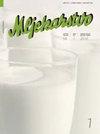奶油和酸奶黄油贮存过程中脂肪酸和农药残留分析
IF 1.1
4区 农林科学
Q3 AGRICULTURE, DAIRY & ANIMAL SCIENCE
引用次数: 0
摘要
评估由奶油(C)或酸奶(Y)生产的黄油样品的脂肪酸(FA)组成和农药残留。结果表明,与奶油黄油相比,酸奶黄油具有更高的健康促进指数(HPI),并且在储存结束时具有整体可接受性得分。酸奶黄油含有62.81克100g-1饱和、3.50克100g-1单不饱和和2.44克100g-1多不饱和脂肪酸,而奶油黄油分别含有69.99克100g-1饱和度、3.57克100g-1一不饱和和2.81克100g-1多元不饱和脂肪酸酯。过氧化物水平从奶油的0.90到酸奶黄油样品的1.44mEq O2 kg-1不等。奶油和酸奶黄油样品的水分含量分别为16.21至13.19和13.83至13.57 g 100g-1,总脂质含量分别为77.5至79.5和83.0至83.5 g 100g-1。黄油样品中的13种农药化合物没有超过法定限量。本文章由计算机程序翻译,如有差异,请以英文原文为准。
Profile of fatty acid and pesticide residues of cream and yoghurt butter during storage
Butter samples produced from cream (C) or yoghurt (Y) were evaluated for fatty acid (FA) composition and pesticide residues. The results showed that yoghurt butter has a higher health-promoting index (HPI) compared to the cream butter and overall acceptability scores at the end of storage. The yoghurt butter contained 62.81 g 100 g-1 saturated, 3.50 g 100 g-1 monounsaturated, and 2.44 g 100 g-1 polyunsaturated fatty acids whereas the cream butter contained 69.99 g 100 g-1 saturated, 3.57 g 100 g-1 monounsaturated and 2.81 g 100 g-1 polyunsaturated fatty acids, respectively. The peroxides levels varied from 0.90 for the cream to 1.44 mEq O2 kg-1 for yoghurt butter samples. The moisture content varied from 16.21 to 13.19 and 13.83 to 13.57 g 100 g-1 and the total lipid content varied from 77.5 to 79.5 and 83.0 to 83.5 g 100 g-1 for cream and yoghurt butter samples, respectively. The 13 pesticide compounds in butter samples did not exceed the legal limits.
求助全文
通过发布文献求助,成功后即可免费获取论文全文。
去求助
来源期刊

Mljekarstvo
Agricultural and Biological Sciences-Animal Science and Zoology
CiteScore
1.90
自引率
41.70%
发文量
18
审稿时长
12 weeks
期刊介绍:
Mljekarstvo is an open access, peer-reviewed international quarterly scientific journal. The first issue was published in 1951, by the Croatian Dairy Operators'' Association (today: Croatian Dairy Union, publisher). In a paper at a Union conference held 28 October 1951 in Zagreb it was said: "Our desire is that this magazine does not meet the fate of its predecessors, but that it continues to reflect the creative efforts and to provide guidelines for the producers as well as all other operators employed in the dairy industry."
It is our pleasure today to say that wishes of the enthusiasts who attended the conference have come true, and the magazine Mljekarstvo during the last six decades was a reflection of the creative efforts of numerous dairy scientists and experts, and through its texts it served as a guideline in improving production and processing of milk and dairy products. Mljekarstvo has been following all the achievements of the dairy profession in Croatia, and it also gives the short surveys of world achievements. The result of the research of local and foreign scientists and experts always find their place in the magazine Mljekarstvo. It has been edited by our outstanding dairy experts employed at colleges, research institutions and dairy companies.
 求助内容:
求助内容: 应助结果提醒方式:
应助结果提醒方式:


